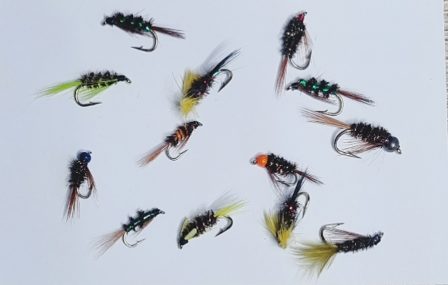1. Fish them on-the-drop
Diawl bachs (pronounced in Welsh as “jawl bachh”) fish well when twiddled slowly using a slow figure of eight retrieve but are often take on-the-drop. After you’ve cast, count to 20 or 30 and let them sink through the depths and keep a close eye on the fly line for signs of movement. If that doesn’t work, twiddle them very slowly back and stop every so often and let them drop again. Their rise and fall through the water column can really draw in fish.
Trout often take diawl bachs on-the-drop.
2. Use a midge or sink tip to get deeper
While you can use a heavier weighted fly, such as an epoxy buzzer, on the point to drag your diawl bachs deeper, or tie the diawl bachs on hooks with a heavier wire, the most reliable method to get the flies lower down is to use a midge tip or sink tip fly line. These fly lines have a floating running line and head and a tip section made from denser intermediate fly line. They can help you get down to deeper water more quickly, which may be essential if you’re fishing from a drifting boat.
Using a midge tip or intermediate helps at times.
3. Try a range of colours
Have a mixture of colours and work through them until you find the type that works on the day. Red is the most commonly used accent colour, but silver, green and blue will also work well in certain conditions.
Diawl bachs are tied in a wide range of colours.
4. Use a blob or FAB to slow their descent
While a heavy buzzer can help diawl bachs descend to deeper water more quickly, sometimes you’ll want to keep the flies closer to the surface. In these situations using either a blob, booby or foam-arsed blob (FAB) can slow their descent letting them stay in the feeding zone for longer.
Blobs and FABs can be used to slow the descent of your diawl bachs to keep them higher in the water for longer.
5. Try a mixture of sizes
Most fly fishers use larger diawl bachs in sizes around a 10. However, it’s worth trying a mixture of sizes from 14-10 to see if scaling down is what’s needed to bring you extra fish.
Do try a variety of sizes other than the standard size 10 or 12.
6. Fish one between two lures
If you’re pulling lures for trout, fishing a diawl bach on the middle dropper between two lures can really help increase your chances. The trout will be drawn in by the colourful, flashy lures and will turn and take the more natural-looking diawl bach instead, as it looks like a safer meal. A gap of at least five feet between the flies is about the minimum to aim for.
When fishing lures, if the trout don’t have the confidence to take the lure they will often take the nymph instead.
7. Fish them on the hang
When your flies near the boat (or the bank, for that matter) stop your retrieve and let them flies drop through the water. If there are fish following, they’ll either take them on the drop or as you lift them back up the surface to re-cast. For some reason, when fishing diawl bachs alongside lures, it’s often the diawl bach which is taken.
Bang! A trout dives for the bottom after taking a fly on the hang.
8. Try them when buzzers are around
Although the diawl bach is a generic nymph imitation and isn’t designed to resemble a specific invertebrate, it can work really well when buzzers are active and when fish are top-and-tailing. In these situations, I’d favour fishing them using the washing line technique, where you use a buoyant point fly to suspend them just below the surface where the fish are active.
Diawl bachs can work well on the washing line.
9. Target pin fry feeders
The flashier diawl bach patterns tied with holographic tinsel and Mirage flash bear a striking resemblance to the pin fry upon which trout feed heavily at certain times of the year. If your lures prove too large to tempt the trout from the tiny and abundant fry, then a flashy looking diawl bach can often be just the thing to trick them.

